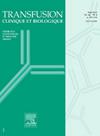Developing a veno-venous extracorporeal membrane oxygenation program during the COVID-19 pandemic: Don’t forget to notify the blood bank
IF 1.2
4区 医学
Q4 HEMATOLOGY
引用次数: 0
Abstract
Objectives
During the SARS-CoV-2 pandemic, there has been significant increased use of vvECMO as rescue therapy. Patients with COVID-19 as anticoagulation is needed for vvECMO support, may develop bleeding complications requiring an increased number of RBC transfusions. We would like to report the RBC transfusion needs following the implementation of an ECMO program. Data on blood usage in this population is important in view of the decline in donations due to the pandemic.
Study Design and Methods
We analyzed data on RBC transfusions in patients who required vvECMO for COVID-19 related ARDS in a Belgian ICU from March 2020 to March 2022. The primary end point was RBC transfusion requirements. and the relationship to outcome. We also analyzed the evolution of this requirement during the four waves.
Results
We admitted 538 patients for hypoxemic ARDS due to COVID-19. Sixty patients (11%) required vvECMO, of whom 27 (45%) died. Forty-seven (78%) of the vvECMO patients were transfused a total of 403 packed RBC units. Sites of hemorrhagic complications were ECMO cannulation sites and lungs. RBC transfusion per patient per day on vvECMO was 0.50 [0.30–0.67] units. There were no differences in hemorrhagic complications in vvECMO survivors and non-survivors.
The percentage of vvECMO patients receiving a RBC transfusion increased slightly during the last COVID-19 wave, with 92 % of patients transfused.
Conclusions
vvECMO program is associated with a major need for RBC transfusions. These data are important when blood availability is decreased due to a pandemic and illustrates the need for studies on optimizing blood management including therapeutic anticoagulation target, threshold for RBC transfusion or alternatives to RBC transfusion.
在 COVID-19 大流行期间制定静脉体外膜氧合计划:别忘了通知血库。
目的:在 SARS-CoV-2 大流行期间,vvECMO 作为抢救疗法的使用显著增加。由于 vvECMO 支持需要抗凝,COVID-19 患者可能会出现出血并发症,需要输注更多的红细胞。我们希望报告实施 ECMO 计划后的红细胞输注需求。鉴于大流行导致献血量减少,有关该人群用血情况的数据非常重要:我们分析了比利时一家重症监护室在 2020 年 3 月至 2022 年 3 月期间因 COVID-19 相关 ARDS 而需要 vvECMO 的患者的 RBC 输血数据。主要终点是RBC输血需求及其与预后的关系。我们还分析了四个阶段中这一需求的变化情况:我们收治了 538 名因 COVID-19 引起的低氧血症 ARDS 患者。60名患者(11%)需要vvECMO,其中27人(45%)死亡。47名(78%)vvECMO患者共输注了403个包装红细胞单位。出血并发症的部位是 ECMO 插管部位和肺部。vvECMO 患者每人每天的红细胞输注量为 0.50 [0.30-0.67] 个单位。vvECMO 存活者和非存活者的出血并发症没有差异。在上一次COVID-19调查中,vvECMO患者接受红细胞输血的比例略有上升,92%的患者接受了输血。这些数据在血液供应因大流行而减少时非常重要,说明有必要研究如何优化血液管理,包括治疗性抗凝目标、输注红细胞的阈值或红细胞输注的替代方案。
本文章由计算机程序翻译,如有差异,请以英文原文为准。
求助全文
约1分钟内获得全文
求助全文
来源期刊
CiteScore
2.50
自引率
11.80%
发文量
234
审稿时长
36 days
期刊介绍:
Transfusion Clinique et Biologique, the official journal of the French Society of Blood Transfusion (SFTS):
- an aid to training, at a European level
- the only French journal indexed in the hematology and immunology sections of Current Contents
Transfusion Clinique et Biologique spans fundamental research and everyday practice, with articles coming from both sides. Articles, reviews, case reports, letters to the editor and editorials are published in 4 editions a year, in French or in English, covering all scientific and medical aspects of transfusion: immunology, hematology, infectious diseases, genetics, molecular biology, etc. And finally, a convivial cross-disciplinary section on training and information offers practical updates.
Readership:
"Transfusers" are many and various: anesthetists, biologists, hematologists, and blood-bank, ICU and mobile emergency specialists...

 求助内容:
求助内容: 应助结果提醒方式:
应助结果提醒方式:


